On this day in Tudor history, 13th January 1599, Elizabethan poet and administrator in Ireland, Edmund Spenser, died in Westminster. He was described as "the prince of poets in his time" and is best known for his allegorical poem in praise of Elizabeth I, "The Faerie Queene".
But, did you know that he also upset William Cecil twice and that his most famous work is actually unfinished?
Find out more about Edmund Spenser in today's talk.
Read Volume 1 of Spenser’s The Faerie Queene at https://archive.org/details/faeriequeene01spen/page/n6
Also on this day in Tudor history, 13th January 1547, poet and soldier, Henry Howard, Earl of Surrey, was tried at Guildhall, found guilty and sentenced to death. Find out why and what happened in my video from last year:
Also on this day in history:
- 1563 – Birth of Mark Alexander Boyd, poet and humanist scholar, in Ayrshire, Scotland. His works included the collections Epistolae quindecim and Epistolae heroides et hymni, and his famous Scots sonnet “Fra banc to banc”.
- 1584- Death of Thomas Wentworth, 2nd Baron Wentworth and de jure 7th Baron Le Despenser, soldier and administrator, at Stepney. Wentworth served Mary I as Lord Deputy of Calais, and was the one in charge when Calais fell to the French in January 1558.
- 1592 – Death of Sir Henry Brooke, courtier and diplomat, at Sutton-at-Hone. Although he was not Baron Cobham himself - that title belonged to his father then brother - he used Cobham as his surname. He served Elizabeth I as an ambassador in Spain, the Low Countries and France, and was the resident ambassador in France from October 1579 to September 1583.
- 1593 – Death of Sir Henry Neville, Groom of Henry VIII's Privy Chamber. He was buried at Waltham St Lawrence in Berkshire.
- 1602 – Death of Sir John Forster, soldier and Warden of the Middle Marches, at Spindlestone, Northumberland. He was buried at Bamburgh parish church.
- 1612 – Death of Jane Suárez de Figueroa (née Dormer), Duchess of Feria. She was buried in the monastery of Santa Clara at Zafra, Spain.
- 1613 – Death of Edward Gresham, astrologer, astronomer, mathematician, magician and writer of the treatise “Astrostereon”. He died in London and was buried at All Saints-the-Less.
- 1628 – Death of Sir Anthony Ashley, Baronet, translator and politician, at Holborn House. He was buried at Wimborne St Giles in Dorset. Ashley published an English edition of Lucas Waghenaer's nautical charts, which he adapted and added to with accounts of Sir Francis Drake's 1587 raid on Cadiz and, of course, the 1588 Spanish Armada. It was published as “The Mariners Mirrour”.
Transcript:
On this day in Tudor history, 13th January 1599, Elizabethan poet and administrator in Ireland, Edmund Spenser, died in Westminster, probably in King Street. He was buried three days later near fellow poet Geoffrey Chaucer in Westminster Abbey. His friend Robert Devereux, Earl of Essex, paid for his burial.
William Camden recorded this epitaph in his guide to the abbey in 1600:
“Here close to Chaucer lies Spenser; nearest to him in genius, so nearest to him in burial. Here near Chaucer, O poet Spenser, you will join a poet, even closer to him in your verse than in your tomb. While you were living, English Poesy lived & clapped her hands; now at the point of death, you dying, she fears to die.”
Spenser’s marble memorial on the south wall of Poet’s Corner in the abbey, reads:
“HEARE LYES (EXPECTING THE SECOND COMMINGE OF OUR SAVIOVR CHRIST JESUS) THE BODY OF EDMOND SPENCER THE PRINCE OF POETS IN HIS TYME WHOSE DIVINE SPIRRIT NEEDS NOE OTHIR WITNESSE THEN THE WORKS WHICH HE LEFT BEHINDE HIM. HE WAS BORNE IN LONDON IN THE YEARE 1553 AND DIED IN THE YEARE 1598.”
If you’re wondering why I said he died in 1599, but his memorial states 1598, that’s because the calendar year in Tudor times started on Lady Day, 25th March.
Spenser is, of course, best known for his allegorical poem “The Faerie Queene”, which was dedicated to Elizabeth I, but here are a few more facts about this Tudor poet…
• He was born around 1552/1553 in London, probably in East or West Smithfield, and very little is known about his family, other than his mother was called Elizabeth.
• He was educated at the Merchant Taylors’ School under humanist educational theorist Richard Mulcaster, and then at Pembroke College, Cambridge, where he earned his bed and board working as a servant.
• Spenser was a precocious boy, translating a series of 21 poems before he started university.
• Spenser was proficient in Latin, Greek, French and Italian, and was mentored by scholar and writer Gabriel Harvey.
• Spenser also undertook secretarial work for patrons such as Sir Henry Norris, the English ambassador to France, while he was a student.
• Spenser attained his BA in 1573 and his MA in 1576.
• By 1579, Spenser had become one of Robert Dudley, Earl of Leicester’s circle and had become acquainted with Sir Philip Sidney, Edward Dyer and Daniel Rogers.
• He married Maccabaeus Childe in October 1579 and the couple went on to have two children: Sylvanus and Katherine. Maccabaeus died in the early 1590s and Spenser married Elizabeth Boyle in 1594, who gave him a son, Peregrine.
• Spenser’s first major work “The Shepheardes Calender”, which contained 12 poems, was published in 1579 and proved to be popular, being reprinted four times in the 1580s and 90s.
• In 1580, he published “Three Proper, and Wittie, Familiar Letters” with his former mentor Gabriel Harvey.
• In 1580, Spenser also worked as private secretary to the Lord Deputy of Ireland, Arthur, Lord Grey of Wilton, and he lived in Ireland from that point until his death.
• In early 1590, his famous work, The Faerie Queene, was published. It is an allegorical work in praise of Elizabeth I, to whom it was dedicated. Elizabeth was represented in the poem by the virgin Belphoebe. It is thought that Spenser was able to read sections out to the queen on a visit to England.
• Historian Andrew Hadfield describes The Faerie Queene as “a new departure in the history of English poetry, being a combination of Italian romance, classical epic, and native English styles, principally derived from Chaucer” and explains how Spenser invented a new form of stanza, “a hybrid form adopted from the Scots poetry of James I, ‘rhyme royal’, and Italian ‘ottava rima’”.
• The Faerie Queene was accompanied by seventeen sonnets dedicated to important courtiers such as Sir Christopher Hatton; Robert Devereux, 2nd Earl of Essex; William Cecil, Lord Burghley; Edward de Vere, 17th Earl of Oxford; Sir Henry Carey, Lord Hunsdon; Sir Walter Ralegh; Sir Francis Walsingham, and Mary Sidney, Countess of Pembroke.
• Here’s an interesting fact, The Faerie Queene is actually unfinished. Spenser planned for it to comprise 12 books, but we only have 7.
• In 1591, Spenser published “Complaints”, a collection of poems “being all complaints and meditations of the worlds vanitie, verie grave and profitable”.
• Spenser upset William Cecil, Lord Burghley, twice, firstly with his allegorical poem, Mother Hubbard’s Tale, in which Cecil appears to have been the fox, and then with a satire of Cecil in his collection “Complaints”.
• It was while Spenser was delivering a letter from his employer, Sir Thomas Norris, who was based in Ireland, to the Privy Council in London, that he died in Westminster on this day in 1599.
• At his funeral, William Camden recorded “his hearse being attended by poets, and mournful elegies and poems, with the pens that wrote them, thrown into the tomb”.
• Spenser was survived by his wife, Elizabeth, and his children, Sylvanus, Katherine and Peregrine.
• Spenser’s other works include “A View of the Present State of Ireland”, prose treatise on the reformation of Ireland which was published posthumously in 1633.
I’ll give you a link to read Volume 1 of Spenser’s The Faerie Queene for yourself, but here is a small excerpt that I like from book 6 canto ix:
It is the mynd, that maketh good or ill,
That maketh wretch or happie, rich or poore:
For some, that hath abundance at his will,
Hath not enough, but wants in greatest store;
And other, that hath litle, askes no more,
But in that litle is both rich and wise.
For wisedome is most riches; fooles therefore
They are, which fortunes doe by vowes devize,
Sith each vnto himselfe his life may fortunize.



Leave a Reply